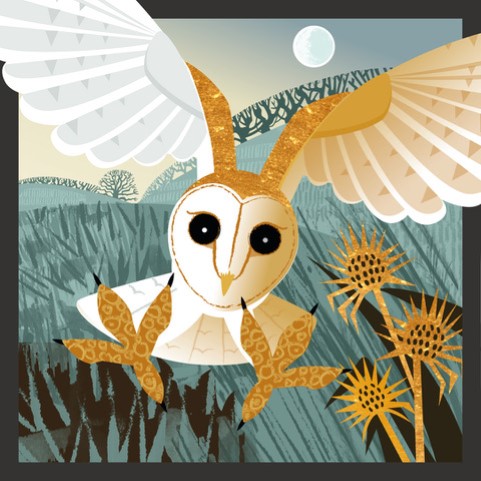21st June – 14th August 2022
From barn owls and brown hares, to harvest mice and hairstreak butterflies, this exhibition takes you on a journey of discovery to meet iconic farmland species, here in the South Downs. It is a collaboration between natural history illustrator, Rachel Hudson and the Selborne Landscape Partnership in Hampshire. It is an exhibition that champions species we are in danger of losing and how the restoration of field margins, from hedgerows to wildflower strips, is making a positive difference. It is also a call to action to support local farmers who are supporting wildlife.
The exhibition is in two parts:
The Selborne Bestiary
This is a wall display of nine illustrated portraits of species that the Partnership is supporting through conservation. It is a visual metaphor for declining species in isolated habitat fragments and the importance of a joined-up ‘mosaic approach’ in conservation that aims to create an interconnected, functioning landscape for wildlife, alongside agriculture. It is informed by ‘compartment portraits’ of medieval bestiaries and encyclopedias that showcase representative beasts and stress the beauty and diversity of the natural world. While drawing on the legacy of medieval art, it will introduce elements from our own contemporary time and place, making a modern bestiary for a new audience.
What happens inbetween the squares of The Selborne Bestiary and how these species can thrive in the contemporary farmed landscape, is explored in ‘Margins’…
Margins
Three two-metre high vertical ‘Margins’ – Hedge, Edge, Strip – show what life can look like when these habitats are planted, managed and reconnected by farmers and volunteers across the landscape. Each margin reveals the energy and struggles of spring, summer and autumn, from the viewpoints of the animals themselves. Three narrative microcosms offer you immersive and surprising views of farmland species and the margins that are so important for their survival. They turn the central convention of medieval marginalia on its head – literally centralising the marginal
and rendering it large-scale to affirm its beauty and purpose. This approach is in response to the site specific spaces at Gilbert White’s House & Gardens and it is in keeping with the ethos of Gilbert White himself, “watching narrowly”, noticing, valuing and passionately recording the often overlooked.
About Rachel Hudson: Rachel Hudson is an illustrator based in Four Marks, Hampshire. She is known for her lively and authentic natural history illustrations for information, greetings cards, publishing, packaging and editorial. Clients include BBC Wildlife Magazine, Bloomsbury Publishing, Butterfly Conservation, the National Trust and The Wildlife Trusts. Her first children’s
non-fiction book, 100 Endangered Species, was published in 2021. http://rachelhudsonillustration.com/
Farmers and conservationists caring for our local landscape
The Selborne Landscape Partnership (SLP) is a cluster of 27 farmers and conservationists restoring nature across the countryside that was home to Gilbert White, the pioneering naturalist. Over the past seven years, whilst doing the day job of producing food, SLP members have been improving habitats to establish wildlife corridors on a bigger, more joined-up landscape scale. By understanding the needs of key target species, a mosaic of nature-rich areas has been enhanced and created to provide year-round food and homes for wildlife. Butterflies, bees, birds, mammals and amphibians are all cared for using a variety of conservation methods including hedgerow management with flowerand seed-rich margins. Alongside this work, much like Gilbert White, our team of 35 active, local volunteers have been observing and recording the wildlife to prove that this collaborative landscape-scale conservation works. Instagram @selbornelandscape

